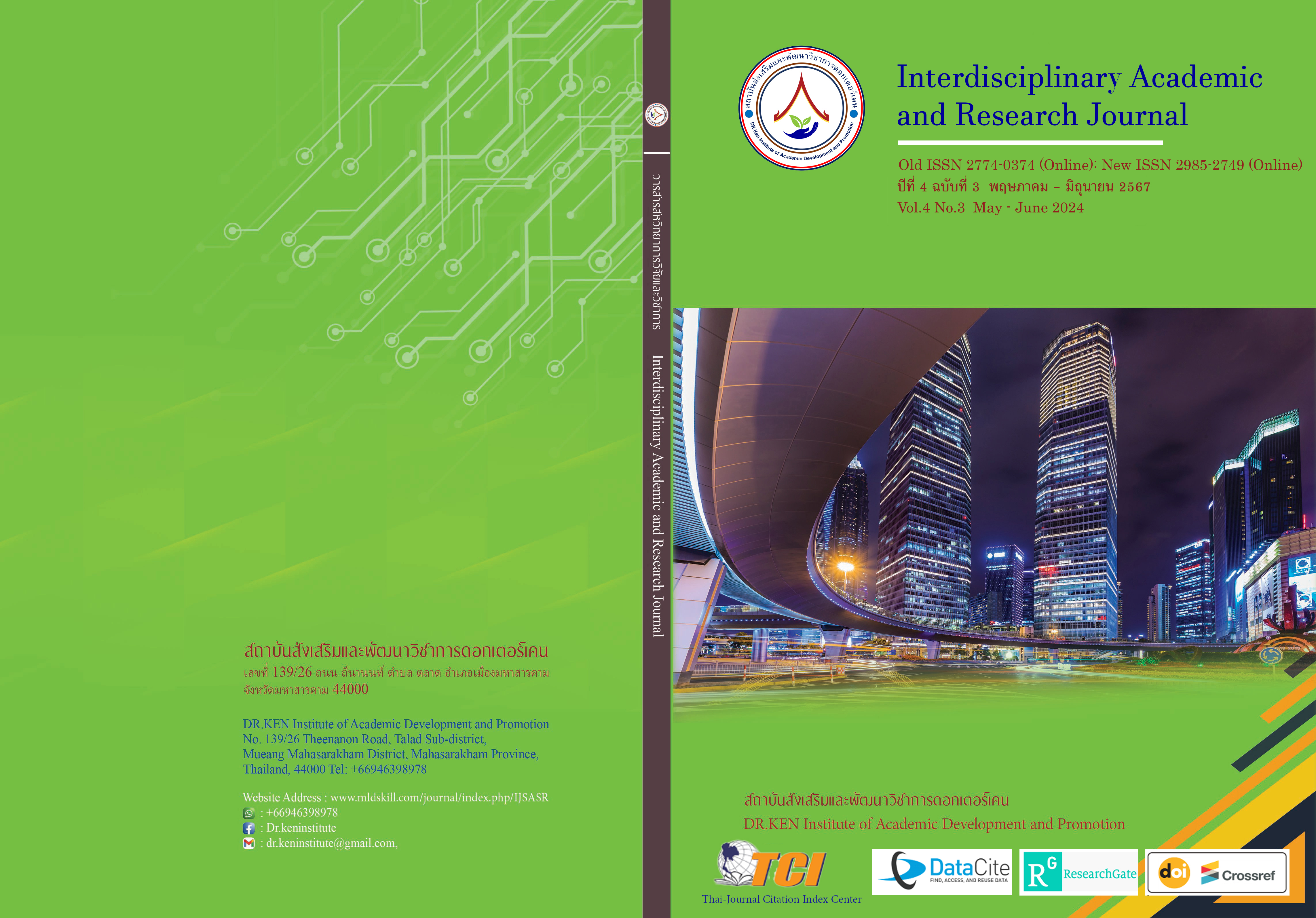Factor Influencing the Efficiency of Small and Medium-sized Enterprises for Import-Export Consumer Goods in Thailand
DOI:
https://doi.org/10.60027/iarj.2024.275470Keywords:
Efficiency; , SMEs; , Import-Export; , Consumer GoodsAbstract
Background and Aims: Import and export companies in Thailand that deal with trading exchanges and the sale of numerous consumer goods in Thailand. To get a competitive edge, import and export company organizations need to build their structures to handle these kinds of issues. Thus, this research aimed to 1) Study the efficiency level of SMEs small and medium-sized enterprises for import-export consumers in Thailand, developing customer relations, entrepreneur traits, administration tactics, and customer loyalty. 2) study causal factors of developing customer relations, entrepreneur traits, administration tactics, and customer loyalty, influencing the efficiency of SMEs small and medium-sized enterprises for the import-export consumer in Thailand. 3) An approach to enhancing the efficiency of SMEs small and medium-sized enterprises for import-export consumers in Thailand.
Methodology: The stratified, was used with 343 import-export administrators, the research tools were questionaries and the statics used for static analyzing were; percentage, average, standard variations, and structural equation modeling (SEM). The qualitative in-depth interviewing and purpose sampling with 16 key informants who experienced higher administration of import-export in Thailand.
Results: (1) The Efficiency level of SMEs small and medium-sized enterprises for the import-export consumer in Thailand, developing customer relations, entrepreneur traits, administration tactics, and customer loyalty, were at a high level. (2) factors of developing customer relations, entrepreneur traits, administration tactics, and customer loyalty, influencing the efficiency of SMEs small and medium-sized enterprises for import-export consumers in Thailand, and (3) There are 6 approaches to enhancing the efficiency of SMEs small and medium-sized enterprises for the import-export consumer in Thailand, which are: 1) develop an excellence service, 2) develop leaders and personnel in an organization, 3) develop both domestic and international marketing plans, 4) developing technology, 5) developing organization culture in participation, and 6) develop goods to international standard. These research findings can be applied by public and private sectors in integrating for SMEs business sustainable.
Conclusion: The results show that Thai SMEs are highly skilled in key domains including customer service, entrepreneurship, management strategies, and client retention. It also identifies important variables that affect SME productivity and offers targeted improvement plans, highlighting the possibility of public-private sector cooperation in promoting sustainable business practices among SMEs.
References
กัลยา วานิชย์ปัญชา. (2560). การใช้SPSS for Windows ในการวิเคราะห์ข้อมูล. พิมพ์ครั้งที่ 28. กรุงเทพฯ: สามลดา.
ธนาคารกรุงศรีอยุธยา. (2566). แนวโน้มธุรกิจและอุตสาหกรรมไทยปี 2566-2568. Retrieved on 25 August 2023 from https://www.krungsri.com/th/research/industry/summary-outlook/industry-outlook-2023-2025.
พัฒน์ พิสิษฐเกษม. (2566). ปัจจัยความสำเร็จในการจัดการโลจิสติกส์และการบูรณาการโซ่อุปทานทุเรียนของสหกรณ์การเกษตรภาคตะวันออก. RMUTT Global Business and Economics Review, 18(1), 26-38.
Andersen, J. (2021). A relational natural-resource-based view on product innovation: The influence of green product innovation and green suppliers on differentiation advantage in small manufacturing firms. Technovation, 104, 102254.
Atulkar, S. (2020). Brand trust and brand loyalty in mall shoppers. Marketing Intelligence & Planning, 38(5), 559-572.
Chowdhury, M.S., Alam, Z., & Arif, M.I. (2019). Success factors of entrepreneur as of small and medium-sized enterprises: Evidence from Bangladesh. Business and Economic Research, 3(2), 38.
Creswell, J.W. (2014). Research Design: Qualitative, Quantitative, and Mixed Methods Approaches. 4th edition. SAGE Publications.
Elliott, M., & Golub, B. (2022). Networks and economic fragility. Annual Review of Economics, 14, 665-696.
Evanschitzky, H., Ramaseshan, B., Woisetschläger, D.M., Richelsen, V., Blut, M., & Backhaus, C. (2012). Consequences of customer loyalty to the loyalty program and the company. Journal of the Academy of Marketing Science, 40(1), 625-638.
Franco, M., & Prata, M. (2019). Influence of the individual characteristics and personality traits of the founder on the performance of family SMEs. European Journal of International Management, 13(1), 41-68.
Gandhi, S.M., Sachdeva, A., & Gupta, A. (2018). Service Quality Models: A Critical Analysis About Their Relevance to Supply Chains of Small-Medium Manufacturing Units. IUP Journal of Supply Chain Management,15(1), 7-39.
Getchell, K., Dubinsky, J., & Lentz, P. (2023). A Critique of Transmission Communication Models in Introductory Management and Organizational Behavior Textbooks. Journal of Management Education, 47(5), 477-504. https://doi.org/10.1177/10525629231182156
Grace, J.B. (2008). Structural equation modeling for observational studies. Journal of Wildlife Management, 72(1), 14-22.
Hassan, S.O., & Abouaish, E.M. (2018). The impact of strategic vs. tactical cause-related marketing on switching intention. International Review on Public and Non-Profit Marketing, 15(1), 253-314.
Kotler, P., & Armstrong, G. (2018). Principles of Marketing. 17th edition. England: Pearson
Lili, Z. (2011). Comparative study of China and USA’s college's entrepreneurship education from an international perspective. Journal of Chinese entrepreneurship, 3(3), 185-194.
Lin, R-J., Chen, R-H. & Chiu, K.K-S. (2010). Customer Relationship Management and Innovation Capability: An Empirical Study. Industrial Management & Data Systems, 110(1),111-133.
Lückenbach, F., Schmidt, H.J., & Henseler, J. (2023). Building brand meaning in social entrepreneurship organizations: the social impact brand model. Journal of Brand Management, 30(3), 207-226.
Nam, D., Lee, J., & Lee, H. (2019). Business Analytics Use in CRM: A Nomological Net from IT Competence to CRM Performance. International Journal of Information Management, 45, 233-245. https://doi.org/10.1016/j.ijinfomgt.2018.01.005
Odhiambo, N.M. (2022). Information technology, income inequality and economic growth in sub-Saharan African countries. Telecommunications Policy, 46(6), 102309.
Ranjan, J., & Foropon, C. (2021). Big data analytics in building the competitive intelligence of organizations. International Journal of Information Management, 56, 102231. DOI: 10.1016/j.ijinfomgt.2020.102231
Sheth, J.N., Sisodia, R.S., & Sharma, A. (2000). The antecedents and consequences of customer-centric marketing. Journal of the Academy of Marketing Science, 28, 55-66. https://doi.org/10.1177/0092070300281006
Wirtz, J. (2018). Managing customer relationships and building loyalty. WS Professional.
Downloads
Published
How to Cite
Issue
Section
License
Copyright (c) 2024 Interdisciplinary Academic and Research Journal

This work is licensed under a Creative Commons Attribution-NonCommercial-NoDerivatives 4.0 International License.
Copyright on any article in the Interdisciplinary Academic and Research Journal is retained by the author(s) under the under the Creative Commons Attribution-NonCommercial-NoDerivatives 4.0 International License. Permission to use text, content, images, etc. of publication. Any user to read, download, copy, distribute, print, search, or link to the full texts of articles, crawl them for indexing, pass them as data to software, or use them for any other lawful purpose. But do not use it for commercial use or with the intent to benefit any business.
















.png)


